Text
U1 - The Stub
This is a stub. Just like this part of the subway line U1.
In the west the U1 begins at the station Uhlandstraße on the very fancy shopping street Kurfürstendamm. The line follows under the street in pretty much a straight line until the station of Kurfürstendamm.

Here the U1 meets the U9 but otherwise just continues further under the street.
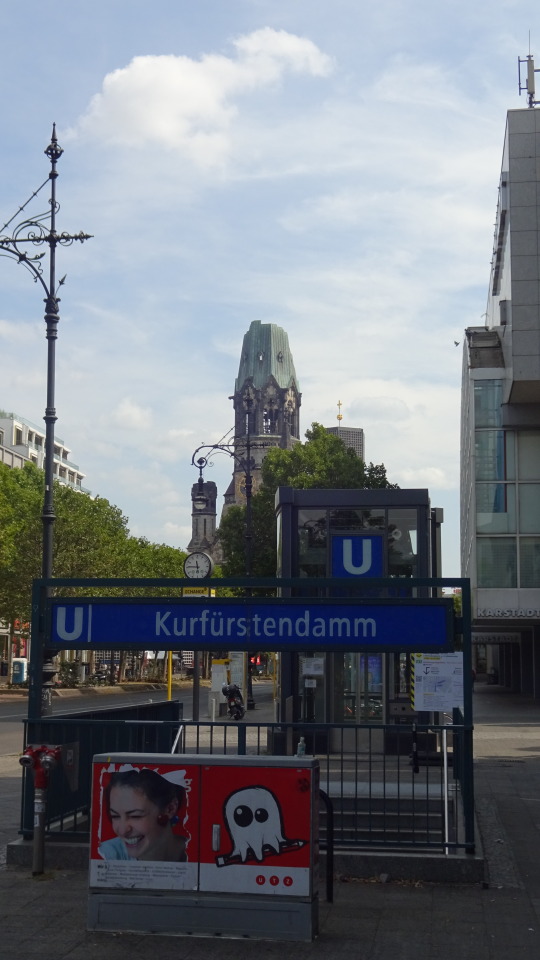
And suddenly after a few more minutes of walking we are here again. At Wittenbergplatz. Where the lines U1, U2 and U3 all meet and start going in parallel.
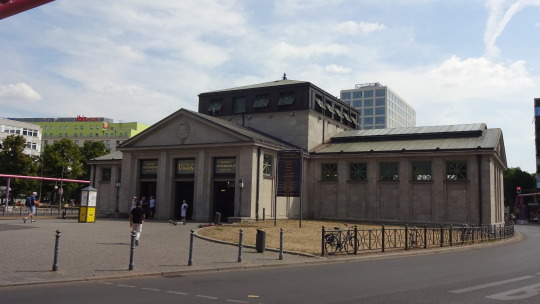
8 notes
·
View notes
Text
U3 - The urban subway
After crossing the Ring it becomes quite obvious that I am now in the city center. The buildings are closer together and consistently multiple stories tall. So from Heidelberger Platz I continue north-west.

[a calm side street in a residential neighborhood; green trees give plenty of shade to the sidewalk and the buildings painted in bright wight and yellow colors]
Similar to the U4 the U3 crosses through a valley halfway between Heidelberger Platz and Fehrbelliner Platz. And in fact this valley is a continuation of the one where the U4 station Rathaus Schöneberg is. But on the U3 there is no station here. Just a bridge over a small lake.

[view over a small lake that is entirely surrounded by green trees]

[a concrete bridge from the side; it has been decorated heavily with graffiti; below one of the arches of the bridge one can see dark, murky water; small ventilation holes reveal that the structure is hollow and hiding the subway from plain sight]
From there it is not far to the next station. Fehrbelliner Platz is where the U3 intersects the comparatively new U7. As a consequence the main station building is a very modern design and apparently there is a nuclear fallout shelter attached to this station. Some of the buildings around this square are used by the city for administration and in case of an attack the workers would evacuate to the station and shelter underground.

[a modern structure with stepped, flat roof pieces that have several rounded corners sits on the other side of a large street; most of the facade is tiled in bright red but a clock tower partially in bright green pokes over the rest of the station]
The line then continues under the Hohenzollerndamm to the station Hohenzollernplatz, both named for the dynasty that ruled over Prussia and then later the German Empire which then due to the incompetence of the Emperor supported Austria-Hungary in the July crisis of 1914 which then led to the first world war and the excruciating death of several million people. Maybe we should think about not naming nice places after awful people like that.

[a staircase to the underground with a station sign is framed by two sturdy rock pillars; on each pillar perches a stone eagle each looking in another direction, seemingly guarding the entrance]
Thematically fitting the next station on the line is Spichernstraße. Named for the small village of Spicheren in France, where a deciding battle in the Franco-German war of 1870 took place. After the German victory in said war, Wilhelm I was crowned emperor of Germany in the occupied Versailles.
Fortunately the place where this station is, is not nearly as grim. It’s a nice and green street with residential buildings and a few shops. The sidewalk is nice and wide and the bike lane forms a really pleasant to ride and safe way to use this straight street to get around.

[the stairs to the station is covered by a blue metal roof; two bikes are parked at frames right next to the entrance; large trees form a green roof for the whole street]
The next station is Augsburger Straße which shares this very simple, modern style of entrance. This station is in fact quite new compared to the rest, as it was opened in 1961 to replace the station Nürnberger Straße. The old station there was deemed too close to the station Spichernstraße which was connected to the U9 at around the same time.

[two stairs to the subway are on opposite sides of a street; each is framed by metal railings to prevent people falling in; a few trees stand in front of modern buildings; a few people mill about the intersection]
From there it is just a few street corners until one suddenly stands in the center of the City West. Wittenbergplatz, for which the station there is named is surrounded by busy stores. The beautiful station building sits right in the center of all the people going to the pricey stores. The U3 is truly a bit magical. With just a bit of time it can get you from a farm to a fancy upper-class department store.

[the station building is built in classical style and looks a bit like a Greek temple; large, blocky columns frame the doors and on window panes above the three entrances is written in golden letters: Bahnhof Wittenberplatz Untergrund Bahn; on a small lawn on the right stands a metal frame with signs; the top one reads: Orte des Schreckens, die wir niemals vergessen dürfen (transl: Places of horror, that we must never forget); the signs beneath list the names of concentration camps]

[a few along the Tauentzienstraße; on the left is the Kaufhaus des Westens, a fancy department store; in the distance among some high rises one can see the Kaiser Wilhelm memorial church, its top a gaping hole; the center of the street has a footpath and green space; thick red pipes snake across the street over the heads of people]
4 notes
·
View notes
Text
maslow’s hierarchy of needs but every level is about soup
20K notes
·
View notes
Text
Reblog to give a trans woman a warm cup of soup

149K notes
·
View notes
Text
U3 - The not rural subway
After the first few stations along the U3 in a previous post, I will now continue with the journey from Dahlem-Dorf northwards.
The first interesting place along the track is the Preussisches Geheimes Staatsarchiv or Prussian Secret State Archive. Of course such a secret entity would be not just stand around in the open for everyone to see. Anyway here is the front of the building which is right next to the subway track.

Here the subway also vanishes into a tunnel and will not see sunlight for quite a while. This makes following it a bit more difficult but I am prepared and know where to go to mostly follow it where possible.
After some more walking I arrive at the station Breitenbachplatz which has a colorful mural on one of the entrances commemorating the station's opening back in 1913.

Slowly it is also more noticeable that this is indeed a city. The buildings are taller and closer together. It is fascinating to see this very gradual change. There are of course green spaces here and there but it very much gets more urban.

And then with a jarring change I arrive at Heidelberger Platz. Here the U3 crosses the Ring, which is a circular part of the railway network which also functions as the border to the Berlin inner city. In some parts of the Ring it is also where the city autobahn runs. Which becomes very obvious in horribly ugly overpasses and incredible amounts of noise. Really not a pretty part of the city.

Before the end of this part of the journey I want to show you one final thing. For the most part as I walk above ground I will not look into the interior of the stations very often. Which is a shame, because some of them are beautifully decorated like these parts of the station Heidelberger Platz.


4 notes
·
View notes
Text
U3 - The rural subway
After my fun walk along the very short U4 I decided to take on a much longer line. The U3. This line goes all the way from the south western edge of the city, straight into the western city center to cross it and terminate in the center of the eastern parts of Berlin. I started this journey in the outskirts in the borough of Zehlendorf.
So first I took the subway all the way to the southern terminus of Krumme Lanke which is named for a nearby, very bendy lake

[platforms of a train station; the sign for the U3 station Krumme Lanke hangs over a green bench; most of the platforms is covered in shade by a simple roof but some bright sunlight reaches the edges]
And yes, a lot of the southern part of this subway line does indeed run above ground. It stays in this kind of trench though so even on the streets right next to the track it is barely audible but still gives nice views onto the trains that pass by occasionally.

[an old class G subway snakes under a bridge over a switch; the bright BVG yellow the train is painted in is a stark contrast to the the green of trees and bushes around; the destination sign reads “Warschauer Straße”]
And it is very understandable that the line was built overground here. Most of the houses are single or two family and it almost feels like you are suddenly in a village somewhere in Brandenburg.

[a side street with single family houses lies in the shade of tall trees; a few cars are parked curbside]
Alongside the track runs a footpath for a long while and most of the time it feels like you are just having a stroll through a park. In a few places you encounter streets that need crossing. This is usually where the subway stations are.
A notable station on that way is Onkel Toms Hütte named for an inn that used to stand nearby which in turn was named after an anti-slavery novel. This stations is somewhat unique in design with two strip malls each running parallel to the platforms. I was not able to get a good picture of this, as there were too many people around I did not want to include in pictures on the internet, but someone on wikipedia got a nice picture from the platform to give you an impression: https://en.wikipedia.org/wiki/Onkel_Toms_H%C3%BCtte_(Berlin_U-Bahn)#/media/File:UbahnOtomshuette.JPG . I kinda like this design making the station the center of the neighborhood. You can easily go shopping a bit when you come home and it fills the station as a whole with a bit more life.
Even further along the line passes the Freie Universität (Free University), the largest of the three universities in Berlin. The station here used to be called Thielplatz but with the establishment of the university its name got changed to Freie Universität (Thielplatz). Always fun when brackets become necessary in station names. That day it was very quiet, but during lecture time lots of students would come here with the U-Bahn as free public transport is included when enrolling in a university in Berlin.
And the next station after that is another treat as well. The entrance building to Dahlem-Dorf (Dahlem village) has a wonderfully thatched roof that gives it a very rural old timey look.

[a small building with a thatched roof and half-timbered facade sits in the bright sun; some moss or lichen have grown on a part of the roof]
I can very much recommend visiting the Domäne Dahlem which is literally right across the street. It is an open air museum and farm which tries to preserve and teach about old techniques for farming and craftsmanship. There are farm animals, a smithy and fields where you can learn about different crops. A wonderful thing to have accessible to city children.

[a field with green crops]

[horses stand on a field grazing]
These are pretty much just highlights. There is so much more to see and explore along the way. And maybe I will get back to some things. But for now these are the first few stations along the U3 and there is still a long way to go.
11 notes
·
View notes
Text
The Berlin subway line U4... above!
A few months ago I shared the story of the tiny line U4 of the Berlin subway network and I thought I was done with this silly little thing. Until I realized, I could follow its course above ground to get a better understanding what places it actually goes to.
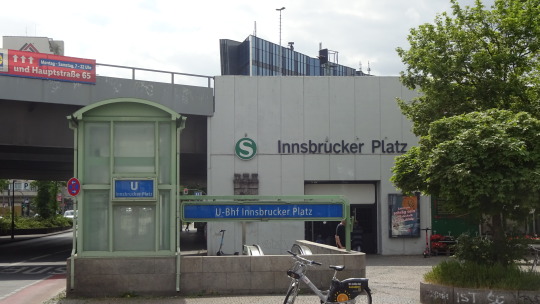
[the S- and U-Bahn stations Innsbrucker Platz as seen from the street; the station name is written three times in large letters]
I start at the station of Innsbrucker Platz again, which is mostly a quite noisy intersection but quickly make my way over to the Innsbrucker Straße under which the subway tunnels go northwards.

[a column with a fountain in front of a few, healthy green trees marks the beginning of the wide Innsbrucker Straße]
The street is technically very wide but most of it is taken up by strip of car parking along the center as well as trees and benches on most of the intersections. It was a nice and quite, casual walk through mostly residential buildings.
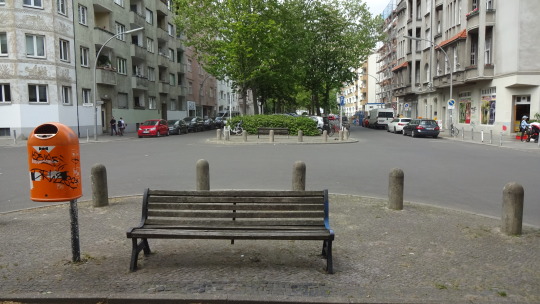
[one of said benches at an intersection; bollards protect this little island from the occasional car coming by]
A short few minutes walking through this residential area later I got to a park. The Volkspark Wilmersdorf is one of the numerous recreational parks built in the early 1900s when Berlin was booming and city planners realized that green spaces would be necessary to provide the city with fresh air and people with space to relax and do sport. The park was partially built in an artificial valley and when then U4 line was built, it was built straight through it.

[the Carl-Zuckmayer-Brücke going straight through the park as seen from one of the stairs leading from the bridge to one of the paths in the park]
The bridge is nowadays completely pedestrianized and as the U4 runs very shallow the trains run right beneath the upper deck. This is also where the station Rathaus Schöneberg is, which is still under some construction work to make it fully accessible. This quite unique situation makes it possible to sit in the park and look through glass windows into a subway station.
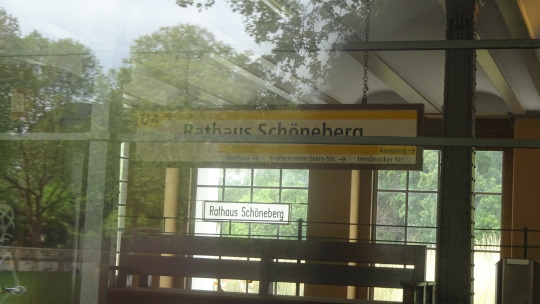
[looking through one of the windows in the station one can see an old an one new station sign as well as one of the benches on the platform]
And on the other hand you can stand on top of a bridge that is also a subway station and enjoy the view into a public park.
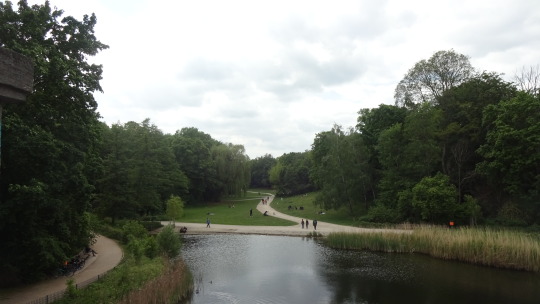
[view from the bridge over a small lake and some paths winding through the green grass and trees of the park; people are sitting on the grass or walking about in the distance]
I continued on my way through more residential area, which was mostly unremarkable. It was quiet and pleasant with more people just walking on foot than cars driving.
Then I reached the Bayerischer Platz, where the Innsbrucker Straße intersects the larger Grunewaldstraße. The station building for the subway is actually quite neat. It sits on an island and has a cafe overlooking the square on top.
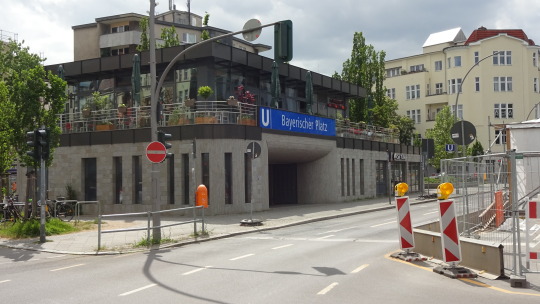
[the modern station building for Bayerischer Platz; potted plants sit on the balcony of the cafe on the first floor]
The square is mostly taken up by a small park. I was not able to get a good picture of it as there was an unsightly construction site and quite a bunch of people around so I just continued on my way without disturbing people.
Unfortunately I messed up slightly and did not follow the bend of the U4 precisely so I only rejoined it at the next station of Viktoria-Luise-Platz. But the way mostly continued through more cozy neighborhoods.
I had taken nice pictures of this square before, but in early summer it is a lot nicer. They even have the fountain going now.
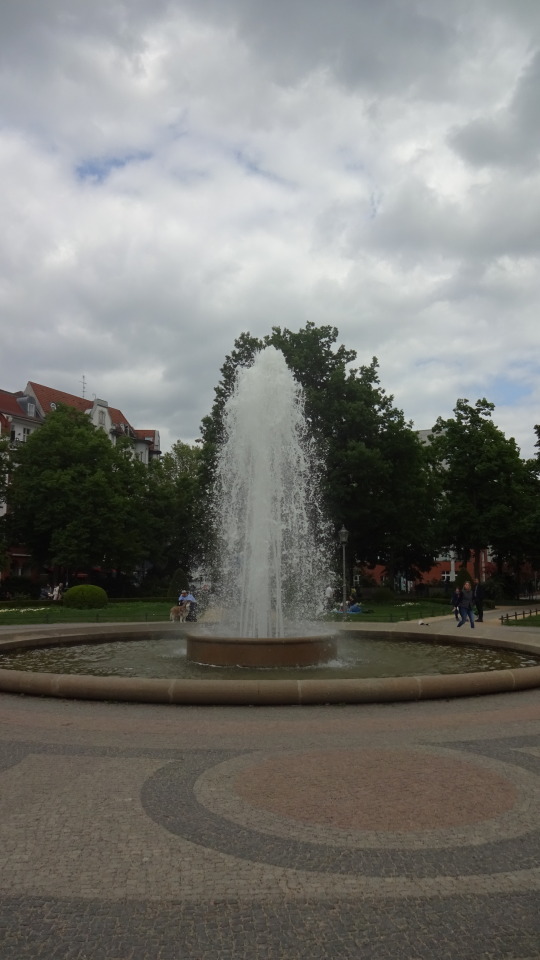
[the big water fountain in the center of Viktoria-Luise-Platz shoots water a few meters into the air; a few people walk and rest among the green grass in the background]
I did not realize it last time but several of the streets leading towards this square are blocked off with bollards, reducing through traffic considerably. I saw quite a lot of people riding bikes as the streets were in nice shape and very quiet. A few cafes were open and had seating on the walkway giving this whole space the low, comforting hum of people being around.
Now properly back on track I followed the line to its northern terminus by walking along Motzstraße. This is the beginning of Nollendorfkiez, which is known for being a center of queer life in the city. Since 1993 this is where during pride the Lesbisch-Schwules-Stadtfest (lesbian-gay city festival) takes place. Most of the time it is just a very cozy neighborhood though.
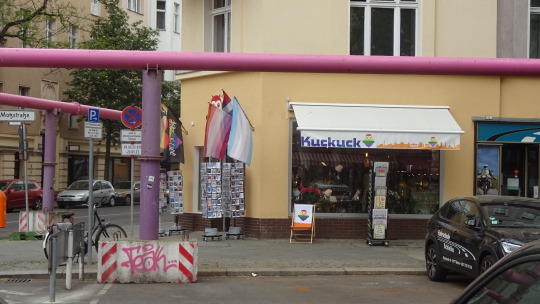
[a small shop on the ground floor of a residential building; several pride flags hang in the breeze]
The Motzstraße ends at Nollendorfplatz with its partially overground subway station where the U4 meets the lines U1, U2 and U3.
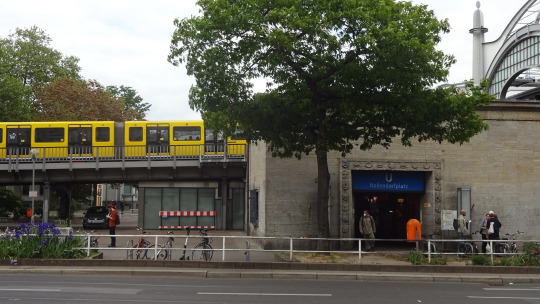
[a train of the U2 pulls into the overground platforms of the station Nollendorfplatz; one of the entrances is just below where the trains runs]
This marks the end of my trip along the U4. This was a lot of fun and a nice way of discovering parts of the city I have not been to before, so I am considering walking along the other eight lines as well. As those are a lot longer, I will have to see how I will manage that and will probably split these trips into multiple parts.
4 notes
·
View notes
Text
Berlin-Potsdam Stammbahn
I have made my way to the S-Bahn station Zehlendorf near the city border of Berlin to see a part of the oldest railway in what was then Prussia.
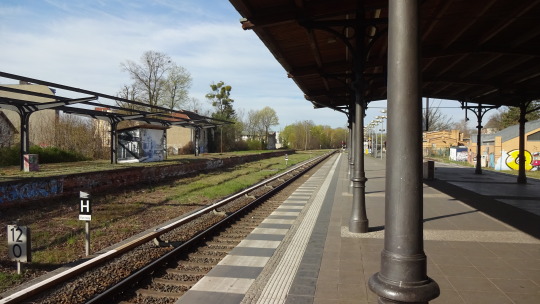
[view along a simple train platform on a sunny day; across the track is another, but nowadays abandoned platform]
The so called Stammbahn was opened in 1838 between the Potsdamer Tor (today Potsdamer Platz) in Berlin and the city center of Potsdam with a length of about 30 kilometres to connect these two most important cities of Prussia. Even though King Friedrich Wilhelm III was initially skeptical about trains, this first line was built to help convince him of the use of this new technology.
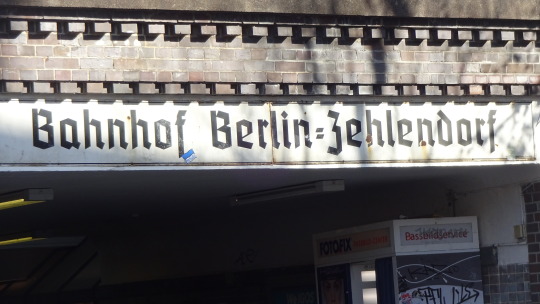
[”Bahnhof Berlin-Zehlendorf” is written in old-timey letters above the station entrance]
And with success. This line was later extended further to reach all the way to Magdeburg and became an important part of the large train network that spanned all of the German Empire decades later. Demand for this connection was so high in fact, that it was expanded to be double tracked in 1847 and even that was not enough. A new line, the Wannseebahn (named for the lake Wannsee right next to it), was built in 1874 in parallel to keep up with ever more increasing demand for fast connections westwards.
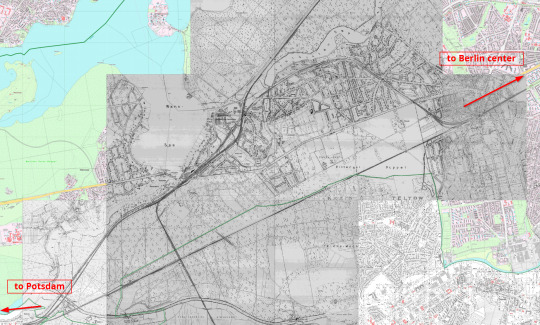
[maps from 1927-1929 showing the Stammbahn in the center going from the North East to the South West in a straight line and the Wannseebahn slightly to the North of it]
On these tracks ran long distance trains to all kinds of destinations and starting in the 1920s commuter trains of the S-Bahn and always freight trains back and forth. Both the Stammbahn and the Wannseebahn were electrified by 1933 to make them fit for the coming era of electric trains and clearly that has lasted to this day and this line is still the backbone of travel to and from Berlin...

[disused track lies overgrown among trees and greenery]
oh...
Well, as is common in Berlin, history happened. WW2 left the Stammbahn mostly intact. The most severe damage came in April of 1945 when German troops blew the bridge across the Teltowkanal as a desperate measure against advancing troops of the Western Allies.
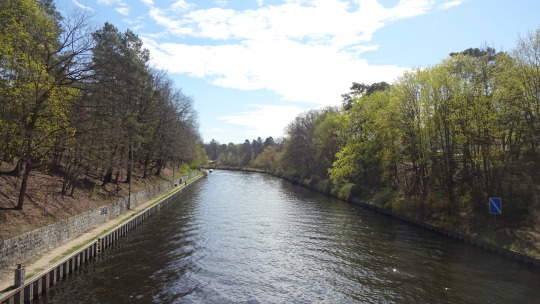
[view over the Teltowkanal from a bridge; the water flows calmly along the trees; somewhere along here would have been the bridge of the Stammbahn]
That did not really help and Berlin was occupied shortly after. As part of the reparations Germany had to pay, one track of the Stammbahn was lifted. Good railroad track is worth a lot of money and can be reused somewhat easily, so selling off part of this railway that forcibly terminated at the Teltowkanal was not a terrible idea.

[a railroad bridge that used to go over a part of the Autobahn here has been colorized with a lot of graffiti]
But then things got worse. With the division into East- and West-Germany and subsequent construction of the Wall, the East-German S-Bahn kept operating the Stammbahn up until the station Düppel but it could only be used by people living in West-Berlin (yes this is complicated; when the city got divided, the S-Bahn was operated completely by the East-German Deutsche Reichsbahn, even within West-Berlin). The only problem being, that there are not that many people living around that area within the borders of West-Berlin, so ridership dropped to nearly nothing. And then things got worse.

[a vertical concrete slab that used to be part of the Berlin Wall is kept near to the former Stammbahn as a memorial; an informational sign is put up next to it]
With tensions during the Cold War rising, many West-Berliners started boycotting the S-Bahn and ridership dropped to pretty much nothing. In 1980 the service between Zehlendorf and Düppel was discontinued.
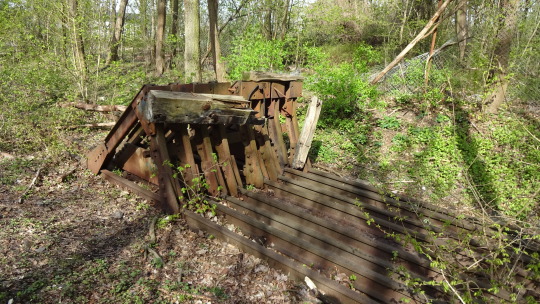
[a rotting buffer stop sits at the end of the line among rusting rails and growing plants]
After the Reunification the Stammbahn was not reconstructed. The Wannseebahn is still to this day taking all the traffic to Potsdam and other lines have picked up traffic to the West. As there are not a lot of people living in this area, the demand for rebuilding the line is not very large.
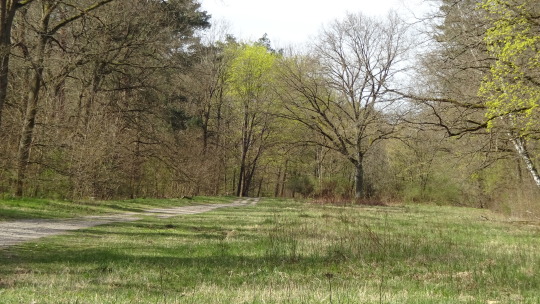
[a dirt path going through green grass and trees; West of Düppel the track has been removed pretty much completely and it is difficult to see where exactly it used to run]
If you want to see this abandoned part of railway history, you can walk the about 12 kilometres between the S-Bahn stations Zehlendorf and Griebnitzsee in probably two and a half hours (your literal mileage may vary). The terrain is not very difficult unless you want to climb onto every embankment you find and has decent paths for walking on. Just make sure you bring good walking shoes. You can easily get there and back home with the S-Bahn.
There is more to see along this hike and it’s not very busy, so it’s a nice trip if you are around.
Also check out http://histomapberlin.de if you ever wanted to look at historical maps of Berlin. It is a free service offered by the city and can give amazing insights into how this city changed in the last 100 years.
7 notes
·
View notes
Text
Halten wie die Dachdecker
A nowadays pretty rare way of saying "You can do this however you want." in German is "Das kannst du machen wie die Dachdecker." literally meaning "You can do that like the roofers."
The origin of that is probably (again) medieval times, where safety had not been invented yet, so climbing on top of a building to roof it was a ridiculously dangerous job and only if you had experience you did so. As a consequence architects and foremen on construction sites rarely dared climbing up there to tell roofers how to do their job.
This led to roofers being able to more or less do as they pleased as long a roof happened and thus this saying became a thing when you don't really care how something is done.
2 notes
·
View notes
Text
Alles in Butter
If you ask a German how something is going they may respond with "Alles in Butter." which translates to "Everything in butter.", which is very odd, right? Is that... good? Should things be in butter?
In fact, they should. This saying has two likely origins but in both cases they mean that all is going well.
The first origin is as is often the case the Medieval times, where fragile goods would be submerged in liquefied butter and could then be transported with less risk of breaking after the butter had solidified again as it formed a shock absorbing cast around the items. And afterwards you could still eat the butter. Or package something else. Butter as reusable packaging.
The other likely origin is that innkeepers would advertise their food as being cooked with butter instead of margarine as that promised a richer taste. Especially in the early days of margarine it had a poor reputation.
Both of these are not literally that relevant anymore. Cooking with plant oil instead of butter is a lot more popular nowadays and other, more convenient packaging material is available, so if you get a package from Germany it will not be filled with butter.
5 notes
·
View notes
Text
Auf dem Holzweg sein
You may very well encounter the saying "auf dem Holzweg sein", so "being on the wooden path" at some point. If you know your history you might first think, that this is a nice thing. In the times before asphalted roads and sewer systems, streets would sometimes have wooden sidewalks, so you would not dirty your shoes in mud and filth. Remember, streets were more or less open sewers in a lot of places. So this surely means that you are walking a good way.
Well, you are on the wooden path there... This saying comes from paths, not made from wood, but rather for wood. They were cut into forests and did not really lead anywhere but the middle of the forest. If you followed one blindly, you would at some point run out of path and get lost among the trees.
So this saying became a way of telling people, that something is unwise and misguided, that will lead to something bad happening. Usually not something absolutely terrible, but at the very least uncomfortable.

[a path in the middle of a forest]
1 note
·
View note
Text
Die Arschkarte ziehen
I recently had some fun writing explanations for German sayings for some of my English speaking friends. Because there is a bunch of sayings like these and I want to share this silliness easier, I have decided to move these to here.
The beginning makes the term "die Arschkarte ziehen" (transl.: drawing the ass-card). As a saying this has only been around for the last 25 years or so. It is usually used as "Da hast du wohl die Arschkarte gezogen." (transl.: You drew the ass-card there.) to mean that a person had bad luck or got into trouble.
The origin is actually very literal and comes from football (or soccer if you will). Referees tend to have a yellow card for lighter offenses in their breast pocket and the red card for serious or repeated offenses in the rear pocket on their pants. This is a useful practice as it means there are two very distinct motions for using either and there is less confusion.
As getting a red card is something quite unpleasant and football very popular in Germany, the card drawn from the ass has been used to mean unfortunate situations being revealed in general.
5 notes
·
View notes
Text
The Berlin subway line U4
I live in the city of Berlin in Germany. I have lived here my whole life and as I don’t own a car I usually move around the city on foot, by bicycle or public transit. And even though I have taken especially subway trains (in German Untergrund-Bahn or U-Bahn for short) through pretty much the whole city, there is a somewhat weird subway line I have never taken in my whole life. It has only ever popped up in the announcements and occasionally I remember that it exists, when I look on the network plan.
The subway line U4 is not only special for me never having used it. It is also the shortest subway line in Berlin with only 5 stations with a total line length of 2.9 kilometers which is shorter than my commute to work on my bike.

[part of the Berlin U-Bahn and S-Bahn network with the yellow U4 line visible; it is dwarfed by all the longer lines in the city; credit BVG, last updated on 2021-07-09]
This lines history is a bit special as well. It was opened on the first of December 1910 by the council of the then still independent town of Schöneberg (now a borough of Berlin). This made it the first publicly owned subway line in Germany. Just one year after its opening it was handed over to the Berlin Hochbahngesellschaft (the company holding the rest of the Berlin subway and elevated railway) to operate it and thus became part of the modern BVG network a few decades later. The Hochbahngesellschaft was not interested in building the line itself, as it was deemed too short to make a profit, but apparently they were content taking over an already built line to integrate into the network.
The whole line was operated pretty much throughout all of the 20th century. It was not affected by serious damage in WW2 and did not get cut off by the wall. It also never got an extension so these five stations have always been on the same line, even though the name and color was changed a few times. The line even used to have its own depot, but when it was physically connected to the rest of the network in 1926 the depot closed in 1932 and trains would get work done on them in the big facilities at Olympiastadion.
So I decided to finally take a trip and ride on this line and take some pictures while I do so.
I started my little excursion at Innsbrucker Platz, where I had arrived with the S-Bahn. I immediately realized that this line is a at a smaller scale in everything. The S-Bahn had been a bit busy which is not unusual for a Saturday morning but in here, it was quiet. I also noticed that the track completely ended at the platform, which is very unusual for the U-Bahn, which usually has sidings in tunnels that continue further on. Only one of the two platforms seemed to be in service that day.

[view to the end of the rail on the platform not in use that day; the tiling on the walls is kept in shining condition and even the old station sign has been kept on the walls; the digital information system hanging from the ceiling seems a bit out of place in this old place and seems to be a bit glitchy as well]
BVG decided to keep the old benches in all of these stations that have signs built on top of them in nice ironwork. They only switched out the actual signs to the modern standard. I like that. Newer benches would have looked out of place next to the heavy iron beams.

[an old wooden bench with an iron frame between two brown iron beams with thick studs visible; apart from the modern signage and a bit of dirt it looks like the day it was built]
Because it was the weekend I had to wait for a few minutes, which gave me enough time to have a look around, for the train to arrive. I had already read that they operate very short two car trains on this line but I was still surprised to see such a short little train when it pulled in. I think I have never sat on a subway train this short. Because there is no siding, the driver just hops out and walks along the platform to the other cabin. While the handful of passengers this train carries disembark and new passengers get on board.

[a model A3 subway has pulled into the station; the passengers have disembarked and the driver is coming over to get into the cabin on the other side]
Just to give you an idea of how short this train looks in comparison to these normal length platforms: the platforms at Innsbrucker Platz are 90 metres long and this two car train is a bit over 25 metres long. You could run a train three times as long on these platforms. It looked absolutely lost. And yet. It was sufficient.
Then I got on the train and rode on the U4 for the first time in my life. Actually not that special. A comfy if a bit screechy ride in the curves like a lot of the older track.
Unfortunately the station Rathaus Schöneberg was undergoing some construction work so I was only able to take a quick snapshot from the train. The construction work is good though as BVG is currently working on getting an elevator on every single station. Maybe I will come back here when they are done.

[the station Rathaus Schöneberg zips by in a blur; the big windows that are unique to this station let in sunlight in the background]
At Bayerischer Platz I got off again to take a short peak outside. The simple entrance is set in the middle of a quiet residential area. The old ticket booth has since been closed as there are now machines.

[the very modest entrance to the station below is almost hidden behind a few bushes; trees and residential buildings can be seen in the background]

[the entrance area and this closed ticket booth are covered in pretty dark blue tiles]

[a lot of the older stations have old pictures on the walls instead of advertisemen like an artists impression of this very station in the early 20th centuryt; these are a lot more interesting to study than the adverts and the platforms seems a lot less visually busy]
Next after that is the station Viktoria-Luise-Platz. This station has an entrance onto said square that is a wonderfully quiet zone surrounded by residential buildings.

[Viktoria-Luise-Platz as seen from the station entrance; there is a circular fountain (not operating as it is winter) in the center, green grass and trees surrounding it; brick residential buildings typical for Berlin surround the calm square]

[a view along one of the empty platforms; the station here has a gray and green color scheme but still keeps the style of ironwork and tiling]
Finally I got on the train for the last bit and arrived at Nollendorfplatz. As the U4 was properly connected to the U1, U2 and U3 here, the old platforms were replaced with newer ones in 1926. The old platforms are not that far and apparently just walled off somewhere.

[as these platforms are a bit newer and connect to multiple other lines they were built a bit wider; escalators have been built in the center and concrete columns have been used instead of iron]
Here my journey ended and I took another line home.
As a kid I asked myself and maybe even you dear reader are asking yourself, why have this silly, little line, that has these short, little trains that is sometimes forgotten and was deemed unprofitable at its inception? But now I think I understand why. It may be a small line, but it is a means of transport for the people living there and probably saves some people detours they would have to take if this line did not exist. Even 111 years after its opening this line is still the fastest way to get from these places to the rest of Berlin. Even though Schöneberg used to be its own town, the decision back then to build a subway has probably helped make it a nice, well connected and relatively quiet part of a big city for the future. This line was never built or maintained to make a profit. This line is there to connect the people living there and the rest of the city. To breathe life into the area and avoid turning the streets into a mess of noise and pollution. I hope it will continue its work for generations to come and maybe even see a bit more passengers.
For some historical pictures, check out https://www.berliner-untergrundbahn.de/st-401.html (in German) which I used to read up on the history of this unique line.
7 notes
·
View notes
Text
Lübeck historic town center
After I had arrived in Lübeck by train I stored my luggage in a locker at the train station as I had arrived a few hours before I could check into my hotel. I guess one lesson I can already draw from this trip, is that I should not take the earliest train if that means I can’t check in for some time.
I spent a lot of the time walking around the old city center of Lübeck. The city center is mostly composed of medieval brick buildings on an island in the river Trave. Some smaller islands are on the western and southern side of the city center that used to be defensive works that were in part converted into public green space. From the hills that used to be walls you can get some nice views over the city and its large churches towering over the rest of the buildings. The city center is not very large and you can easily cross it on foot in about 15 minutes.

[view from one of the hills towards the old town; five church towers peak over the rest of the buildings]
That day and on the Monday I walked around the city a lot trying to peek into every street and I certainly can understand why this was declared cultural heritage. The large churches and other city buildings show the amount of money that flowed through the city in the days of the Hansa. When ships sailed to ports in the Baltic and the North Sea fully loaded with goods to make a fortune. The city grew rich and soon houses were crammed close to each other in narrow streets. And to cross between these streets the people built a small walkways through the buildings and backyards. Some of them seem to be still in use. I did not want to disturb people living there so all I took was a few pictures. Especially in the eastern part of the city everything is quite calm and seems to not have changed that much. Unless a large garbage truck rumbles over the cobblestone street.

[an open archway leads through a house into a backyard; the way itself is dark and only a some sunlight is shining from the other side]
But here is also where I should be a bit critical about this journey. While some parts of Lübeck are nice and quiet with its historic buildings being a wonderful sight, especially the western part of the city center is a terrible mess of car traffic. The Holstentor is a big gate marking the entrance to the center which is prominent for it having sunk in the middle under its own weight a bit. It once connected to the city wall and nowadays sits in the middle of heavy traffic. It was incredibly busy and noisy with cars all day here.

[the Holstentor on a cloudy day; the brick gate is decorated with statues and has pointy roofs]
And it is not much better for major parts of the western side of the city center. Cars are everywhere in the narrow streets. The sidewalks barely fit two people side by side and cars are parked in most streets. At times I felt less safe crossing these small streets than in bustling Berlin.
While there was some bike lanes on the periphery, in the actual city center that was mostly not the case. I also very much noticed, again to my surprise how very loud the traffic noise was. I think it is a mix of the narrow streets with high building facades (usually 2 or 3 stories with little to no gaps) which reflect the sound and an utter lack of foliage. Berlin is far from perfect, but there are trees nearly everywhere and they really help absorbing and breaking up sound from cars. Something I dearly missed in Lübeck.

[view along a narrow side street; arches have been constructed over the cobblestone street to connect the buildings on either side]
There is public transport in the form of about a dozen bus lines, but they are all routed around the Holstentor which becomes a terrible bottleneck. At least two times I saw three buses in a row sitting in dense traffic and the bus drivers became even fed up with each other with one bus driver honking at another one.
You might think that there might be some peace and quiet along the river, but unfortunately a lot of the riverside is taken up by vast parking spaces. This availability of car parking makes it very appealing to people from out of town to come with their cars, which just makes traffic a lot worse.
After a while I retreated to my hotel room to get some quiet time. Just a nice green area to relax would have been nice. But I was always close to a car parking space or a major street. The city had even built roads on the green islands that used to be part of the defensive works.
It seems that there is not much left of the medieval city that by technological necessity used to be walkable when it was built. It got taken over by cars and noise to a large degree. I am in the end kinda glad I only stayed for a short duration.

[several boats are anchored in the river Trave; houses typical for the Lübeck town center are behind them]
But the situation might improve. I saw advertisements for political campaigns to improve bike infrastructure. In the end I believe that especially an old city center like this one would immensely improve with a ban on car traffic. Of course this only means banning private car owner. Transporters, services and emergency vehicles would still operate. But those were pretty scarce, so basically nothing would be left of the terrible noise and the streets would be safe and pleasant to walk and admire this wonderful coastal town that has an interesting story to tell.
2 notes
·
View notes
Text
Weekend trip to Lübeck
In the next few posts I want to talk about the weekend trip to the city of Lübeck I took in mid October. This was pretty much a test run for a potential series I want to do where I travel to all of the UNESCO cultural heritage sites in Germany. I’m still debating this, as this is really a lot of places I would have to visit but in any case I wanted to start with one to see what kind of things I would need to consider when doing trips like these.
I took Lübeck mostly on a whim, because it’s not too far away and finding a hotel and restaurants to grab food was easy enough.
Because I am apparently very cheap I decided to take the least expensive train ticket to Lübeck, which was an ICE departing Berlin for Hamburg at 6 in the morning on Saturday and then a regional train from Hamburg to Lübeck for about 25€ in total. The planned journey was scheduled to take about 4 hours so I would arrive in the old hanseatic town at around 10.

[the rough route of the journey is marked in a red line on a map; the line starts in Berlin, goes north west to Hamburg and then for a shorter bit north east to Lübeck; map: © OpenStreetMap contributors]
When the morning came I slightly regretted taking a train this early. I had to get up at around 5:00 to get dressed, grab a few last things to put into my backpack and then head out to catch the subway to Berlin central station.
And that worked like a charm. I had bought my DB ticket as a +City ticket so it also functioned as a public transport ticket saving a bit of time. A bit ahead of time I had arrived on the upper S-Bahn platforms and took the long elevator down to the lower platforms where my ICE would depart from.

[view from one of the elevators onto some of the lower platforms in Berlin central station; the building is brightly lit, a few people are waiting for their trains and a DB duplex train is sitting at one of the platforms]
It was not very busy so when the train arrived and I had an easy time finding a nice seat. Due to track work between Berlin and Hamburg that portion of the journey took a bit longer, but two and a half hours are not an uncomfortable time to spend in these seats.

[a railyard south of Hamburg zips by in the early morning sun;freight cars sit on dozens of parallel tracks; a dark red building pokes up in the distance among all the track]
The darkness of the early autumn morning soon lightened up and I could look out the window just watching towns and fields zip by. Still a bit sleepy I finally had some breakfast in the form of a few bread rolls I had prepared the previous evening. I am still hesitant to buy food on the train as it seems somewhat overpriced, so I tend to bring my own.
The train arrived with just a tiny delay of about two minutes which was perfectly fine for the change I had to make within 34 minutes. I waited patiently for the Regional Express train to show up and just watched the slow morning traffic come and go.

[looking down on the platforms at Hamburg central station; the large hall is comparatively empty with only some platforms being busy at this time; still there are S-Bahn trains on the left and two regional trains on other platforms; the sun shines comfortably through the glass in the roof of the large hall]
The RE on the line 8 pulled up right on time and filled quite rapidly. This line is frequented about once an hour and that seems absolutely necessary. Even on a cloudy, off-season Saturday this double decker commuter train got somewhat full. It was still pleasant and nobody had to stand, but I can see these getting more cramped in the summer when people take these to go to the beach.
These duplex trains are not as well suited to traveling with larger pieces of luggage as the overhead racks are quite small. But they were certainly enough to hold my stuff I brought for the weekend.
If you ride one of these for at least a while, I very much recommend taking a seat at the top. The view is just nicer with the curved windows also allowing you to easily look up and the distance to the wheels means it is usually a bit quieter. Swaying motions from side to side are a bit more pronounced up there though so if you are sensitive to motion sickness it may be better to stay on the lower deck, which is still comfortable.
Additionally, you might want to consider spending a bit more on a first class ticket in these RE trains if you are, like me, quite tall. As these are trains intended for shorter rides, they are designed with little leg room, which make them a bit uncomfortable to ride for longer than an hour.
As this ride only took about 40 minutes I stayed in second class and was fine. I arrived in the nice train station in Lübeck with just a few minutes delay.

[platfoms 4 and 5 in Lübeck central station; a duplex train sits on the left side while another regional train sits on the right side of the picture; only a three people are standing on the platform; large metal beams are visible on the right of the picture holding up the canopy built with glass, metal and wood; diffuse but comfortable light comes from the ceiling]
The station was being quite busy but as it is not very large I easily found my way around up from the platform to the main concourse with its few shops and ticket machines and out the door onto the street.

[the main entrance to Lübeck central station in daylight; the red brick building has four small decorative towers all tipped with greened copper; three arches form most of the front of the building with the upper half of them filled with glass to let in light into the hall and entrances into the building protected by a greened copper roof each; the windows and arches are decorated with reliefs in white stone]
3 notes
·
View notes
Text
Back from Sweden to Germany
As the journey to Sweden was certainly not what I initially planned, I decided to write about my journey back to Berlin as well, as that turned out to be a quite different sort of adventure.
To make it through the 13 hour journey and arrive in Berlin with enough time to get dinner, I decided to take the 6:35 train from Gothenburg down to Malmö. I was delighted to find that Gothenburg central station is lit up beautifully during the night and even while it was pretty dark in the early morning the station felt bright and inviting on the inside.

[Gothenburg central station lit up in warm colors in the early morning hours; a few people walk towards it]
Just like when I arrived a week earlier the SJ high speed train departed right on time and provided a very comfortable trip and even though it was cloudy and rainy the view was certainly enjoyable.

[green and calm countryside zips by while gray rainclouds hang in the sky]
I also must remark on how wide the Swedish trains are. The rail is set up to leave a lot more space to the sides (they have a wide loading gauge) and thus even in a 2 by 2 open saloon it does not feel cramped at all. The walkway in the center is wide enough to comfortably carry luggage, the seats have normal width and there is still space for a small nook with a table next to the window, where you can place small items or a bag.
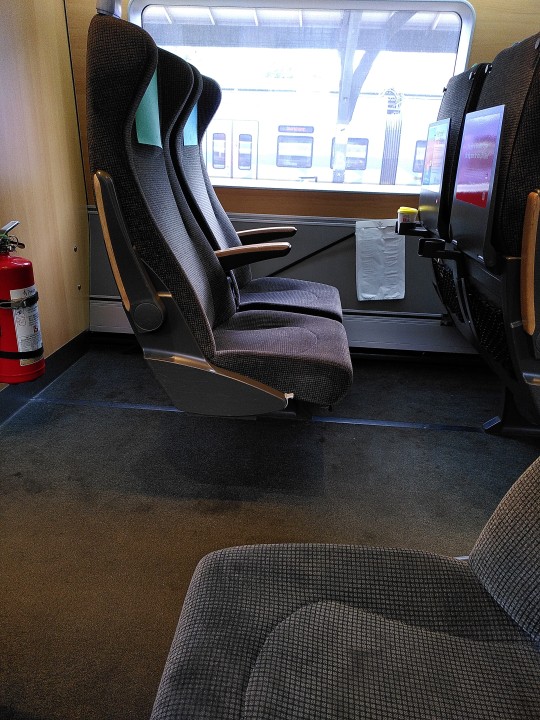
[some empty train seats in a Swedish X55 train attempting to show how wide these are]
When I was in Malmö the first time I didn’t have the time to really take in the station, which turns out to be quite nice. It looks clean and is large enough that even on a busy Monday it did not feel uncomfortably crowded. While the upper platforms and concourse are bright from sunlight and lighting, the underground platforms are a bit darker, but still kept in very good shape and look modern.

[the upper platforms at Malmö central station; the hall is pleasant and bright and there is a different train sitting on each platform; pretty iron works holds up the roof of the hall]

[a view along some of the lower platforms at Malmö central station; the modern architecture with simpler shapes and more artificial lighting form a noticeable contrast to the platforms above]
An Öresundtåg then took me over to Copenhagen. Despite the check by the Danish border police again, that trip was pretty quick and comfortable. I decided to sit in a section specifically built for bikes, strollers, wheelchairs and large luggage, which is a very handy thing for such a regional train which also stops at the airport.
Copenhagen central station really surprised me. The current station was opened in 1911 and looked a lot larger to me than it seems to be with six platforms. The hall was just so spacious that it felt comfortable even on a busy day.

[standing on a bridge over the six platforms of Copenhagen central station looking down on some waiting trains; the large hall hides some parts of the platforms]
If I had had more time, I would have loved to explore the building, as the hall already looked imposing with it’s steel roof with ceiling windows at the apex. Even with the gray weather it was so bright as if there was no roof at all.

[a look up at the ceiling of the train hall; the roof is held up again by red and gray painted metal works and large windows let in plenty of light; even without lit electrical lighting one can easily see]
But after a bit of waiting it was time to board my Intercity train to Hamburg. That part of the journey turned out to be a slight slog in fact. Longer sections of the 6 hour long way to Hamburg were spent at only moderate speeds. But on the other hand I got to see the crossing of the Kiel canal in daylight this time and it was really interesting watching the train snake up the Rendsburg loop to get to the altitude necessary to cross a canal built for ocean freighters and cruise ships.

[a view down from the Rendburg loop onto single family houses of the town of Rendsburg which are encircled by the loop itself; in the distance one can see the bridge over the Kiel canal]
The train was quite packed, but the seats were comfortable so I was perfectly happy just spending the time by myself and watching the scenery. Be aware that there was no on board bistro even on a trip that long. The crew came through with a few snacks for purchase, but it’s probably best to bring a few supplies that will last you yourself. This might also be an exception with the pandemic still going on, so a bistro service may be available in the future again.
As the Danish train crossed into Germany there was no loco change this time. Instead it just switched to diesel power and carried on for the last 2 hours. There were no border checks, but my ticket got checked again by the German staff, which was completely fine.
With about 15 minutes delay the train then pulled into Hamburg central station, which I had previously only seen little of during my journey to Sweden. In the afternoon daylight I realized how large and impressive the main hall is. Next time I pass through this station I will try to spend more time on the concourse and watch the trains and crowds below. But that day I was already pretty tired so I opted to have a sit for about an hour.
During that time I noticed how very busy the platforms are. While I was waiting about 4 ICEs and one IC pulled up, unloaded passengers, took on other passengers and then got on their way again on the platform where I was sitting alone. It was mesmerizing to watch. Meanwhile there were regional trains constantly waiting for departure or currently departing on the platform I had my back to. No wonder they are planning to expand the station if this is just what a normal Monday looks like.

[a view down onto the platforms of Hamburg central station in the huge hall the people down below look tiny]
When my train pulled in I was worried about getting a seat, as the platform had been very full, but that was absolutely no issue in the end and there were plenty of seats free for all of the journey to Berlin. Even though the train barely went at 200 km/h for some time due to larger track work, the two and a half hour journey was quite pleasant again. It was a quiet trip through rural Germany with lots of fields and forests to look at and only two short stops along the way.
At around 20:00 after 13 hours on trains and in stations I had arrived back in Berlin. I decided to hop off at Spandau which is a smaller station in the west of the city to take public transport back to my place. Tired and happy but also a bit sad that my adventure had come to an end I got back home.
In conclusion
Covering this distance during the day was more interesting as I got to see some wonderful sights along the track, but it did get a bit tiring. I am glad night train connections up to Sweden exist and are getting extended, so you can use this travel time to get some sleep and spend the day visiting wonderful places.
4 notes
·
View notes
Text
Traveling to Sweden by train
Things are slowly calming down again so I decided to spend a one week vacation in the Swedish city of Gothenburg. I want to share this journey with people as I promised friends to take lots of pictures anyway and because it personally means quite a lot to me to finally get out there again. Not only is this finally a proper vacation after a year and a half of sitting at home a lot with the coronavirus pandemic making it unfeasible to travel anywhere farther than where the S-Bahn could carry me. But this is also my first international journey in just over 10 years. Finally I feel comfortable taking on such a trek and because I am apparently a bit silly and like trains I decided to do this journey (nearly) all by train.
Planned route
Now how does one get from Berlin to Gothenburg by train? The route I will be taking starts in Berlin from which I will first board an ICE (InterCity Express; the German high speed train class of DB) to Hamburg to change to an IC (InterCity; a high-ish speed service) which is a joint operation by DB and the Danish national train service taking me all the way to the Danish capital of Copenhagen. From there I can take the Öresundtåg (literally Öresundtrain) over the Öresundbridge across the (can you guess it?) Öresund between Denmark and Sweden. The Öresundtåg stops in the city of Malmö, where I get a high speed train by the Swedish operator SJ that will get me to my destination.
This is quite a trip with a few changes and because I planned this with change times of at least 30 minutes in case there are delays the whole journey will take about 13 hours. The straight distance between the two cities is about 580 kilometres but due to the detour over Jutland the distance actually traveled is closer to 1000 kilometres.
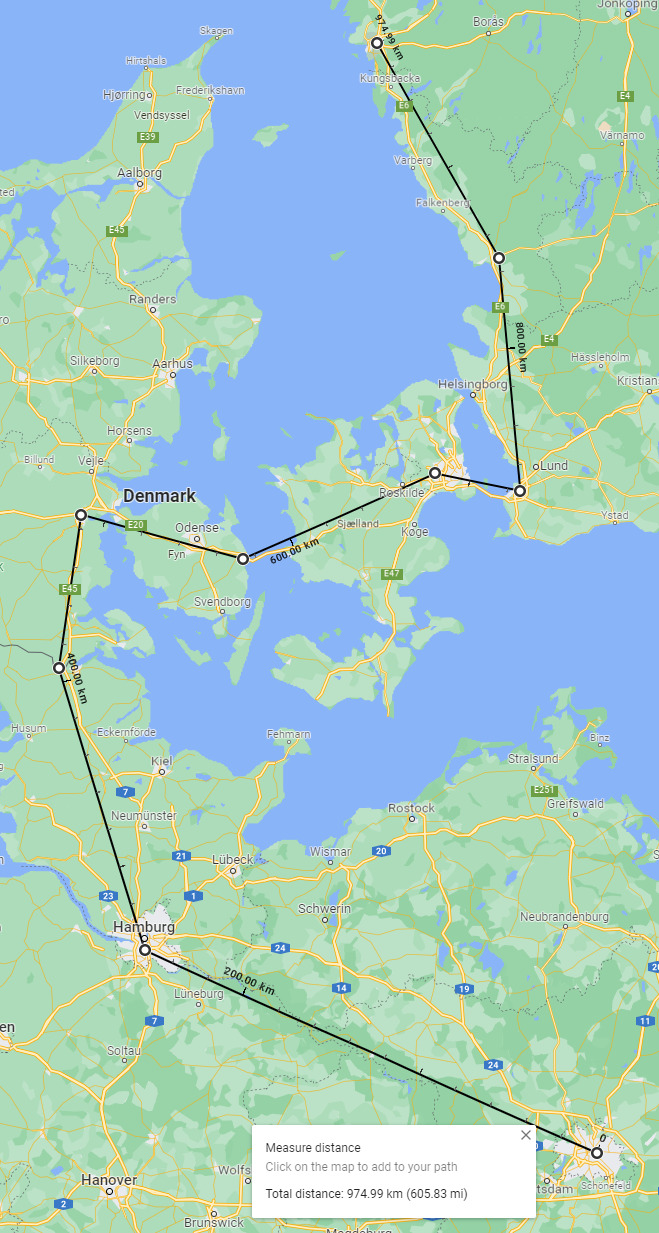
(the route vaguely traced in Google Maps)
I booked the tickets online a few weeks ahead and paid for all second class tickets about 70 € in total (and again about 70 € for the return trip). This was actually quite pleasant. The whole first part of the journey up to Malmö I was able to plan with the website of DB, which cooperates nicely with services of neighboring countries. The booking website of SJ was also easy to use, very user friendly and has a good English translation.
The paperwork
So because this is an international journey we have to consider paperwork of course. You can’t just travel to another country, surely there is a bunch of hoops you have to jump through, right? Well, because of the circumstances, kinda but not really.
First off: no visa required. I am a German citizen and am thus allowed to travel freely within the Schengen-area and the only required document is my ID card. And that is only in case I actually get carded. On train connections that is only done occasionally, but of course I will have my ID with me, so that will not be an issue.
Due to the ongoing Covid-19 pandemic it is also necessary to bring either a negative test result when crossing borders or a certificate of vaccination against the virus. Which I got. You can have it in paper or digitally and two weeks after your second shot you are free to travel again. No quarantining or anything. I got vaccinated anyway, so this was no issue at all.
Over all this got sorted pretty easily and I quickly had everything I need.
As a slight hint for anyone traveling to Sweden for the first time: paying in cash is incredibly uncommon especially in the cities there so I very much advise getting a credit card. I used a simple card I could charge with a bit of money, which I got from my bank with no additional cost and due to the limited money on it, losing it would not have been that bad as well.
Potential obstacles
But of course, stuff happened. Or rather, would maybe happen. I am writing this portion slightly ahead and at the end of reading this you will know, how it actually played out. As will I know, because by then I hopefully will have arrived.
Over the summer of 2021 the train drivers union GDL started talks with DB about raises and compensation over the additional hours drivers had done during the pandemic. Talks broke down though and thus they started striking.
There are more internal factors at play here as well but I am not in the know enough to properly judge or even explain the whole picture. But in the end it also does not really matter because I can’t really change it that quickly. So I have to live with the potential of the trains in Germany being canceled due to strikes. Only in Germany though. As soon as I reach Denmark I will be fine.
The strikes are not full time. They usually go on for two or three days and then normal service resumes within a few hours. And they tend to stick to work days. Which might mean I get lucky as I will depart on a Saturday. But I will watch the news closely and may have to rapidly come up with a backup plan.
Additionally and a bit hilariously I will have to switch onto a rail replacement bus on my journey to Gothenburg. Just on the weekend where I will travel they are doing some bridgework between Malmö and the town of Lund. This is certainly an inconvenience, but I just hope it will work out okay, as it is not that far to Lund. If this was not the case, I would have been able to make this journey exclusively with electric trains.
The strike
And of course it had to happen. On Monday the 30th of August the union announced a strike that would cover a whole week and with that, cover the weekend I wanted to travel on.
But no reason to panic yet. This gave me a few days to figure out how to navigate around this. By Tuesday afternoon DB had figured out which services would still be running.
I got pretty unlucky though. During this strike no DB service would run from Hamburg to Copenhagen. So it became necessary to find another way.
Thankfully I remembered the provider Snälltåget. They run a night train from Berlin all the way to Stockholm with stops in larger cities. Like for example Malmö.
And so for an additional price of just 10€ in total I got my DB ticket refunded, bought a ticket for the Snälltåget service from Saturday 7 in the evening to arrive on Sunday at around 8 in the morning and shifted the ticket I had bought with SJ to a train on Sunday.
Overall that was not nearly as bad as I initially feared and by Tuesday afternoon I had rescheduled.
The journey
Saturday came and in the evening it got time to head out. Due to the strike the S-Bahn service in Berlin was also pretty dodgy so I opted for a route with U-Bahn and bus. Which worked pretty well. The bus was a bit crowded but the whole trip was only a few minutes slower than any S-Bahn connection available to me.
Berlin central station is a very modern steel and glass construction that is very vertical with platforms going east-west above ground and platforms going north-south below ground. Due to the strike there were only few trains around but there were still some passengers taking the few trains in service.
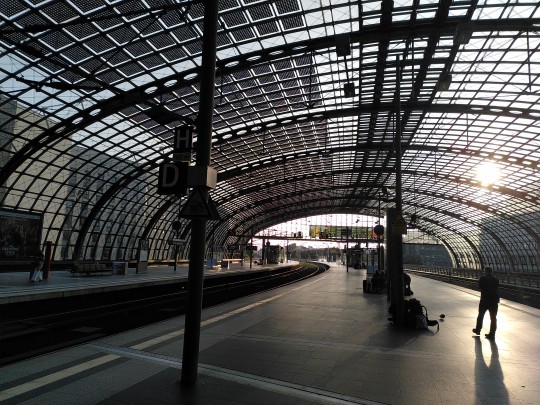
(a view along the upper platforms at Berlin central station with the low sun shining through the glass roof)
About 20 minutes before departure my train pulled onto the platform. Four carriages pulled by an electric loco. Very quickly I had found my seat and was happy to see us depart perfectly on time at 19:02. But then had to stop for twenty minutes just after leaving the city behind, because unauthorized people were on the track.
For this section with Snälltåget I had booked the most basic seat. Fortunately the person who boarded the train in Hamburg at around 22:00 seated next to me found another free seat, so neither of us had to be crammed in our seats and attempt to sleep.
Ah yes, sleep. As this was a night train a reasonable thing to do is to sleep. Unfortunately a few things got in the way of that. Firstly, the cabin light in the open saloon was never turned off. It was comparatively low, but still bright enough to disrupt sleep.
And then came the stop just behind the Danish border. In the small town Padborg, the loco that had hauled us all the way from Berlin got replaced by a Danish locomotive. This is due to a difference in voltage between the countries’ catenary equipment. That alone would have been fine, but unfortunately the Danish border guards deem it necessary to check every single train. And if that means disrupting 200 peoples sleep each night at 2 in the morning then they will do it. Which is what they did.
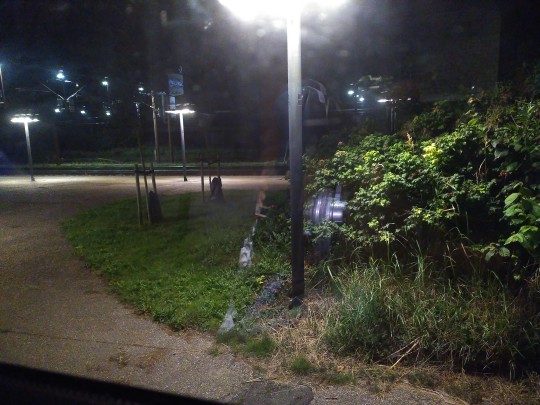
(empty platforms at Padborg, only some bright lamps break the darkness in the dead of night while the border guards board the train)
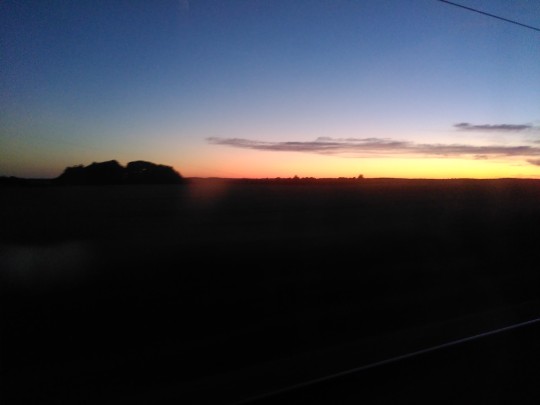
(the sun is just barely rising over the flat and still dark Danish countryside)
During the next few hours I managed to catch a bit of uneasy sleep until the early dawn. Because I realized, that we were nearing Copenhagen I decided to just stay awake and watch the landscape zip by as the sun crept up. And it was worth it.

(banks of mist over fields)
Fields covered in mist like ghostly apparitions. And right as the sun really rose and made it easy to see, we crossed the Öresundbridge. A wonderful view.
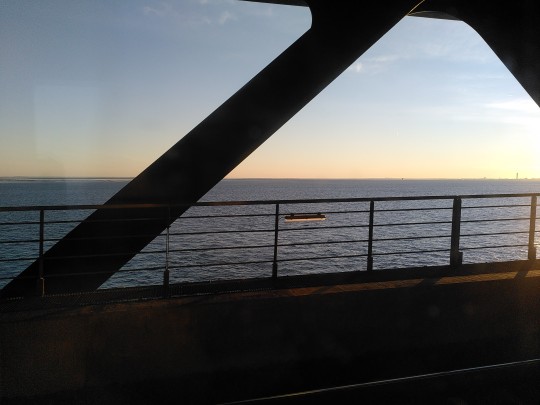
(the metal frame of the Öresundbridge with the sea visible in the background, the sun is shining just out of frame to the right)
After the bridge it was not far to the city of Malmö. Unfortunately we were delayed slightly again. Slowly I felt like fate was trying to keep me from reaching my destination.
But because I was cautious this delay was not enough to mess with my plans. The train arrived slightly delayed at around 08:30.

(the loco that had pulled me through the bit of Sweden I had crossed this far sitting at a platform in Malmö)
I did not take time to look at Malmö central station, but from what I saw it is a nice station with the older platforms being complemented by a modern building housing some shops. But I had a bus to catch, so I headed for one of the exits.
Some helpful staff was able to point me to the replacement bus I now had to take to get to Lund. The bus trip, while a bit inconvenient was actually a nice change. And I got dropped off right in front of the train station an hour before my train was due to depart.
And that last leg of the journey was very pleasant. The X55 even in second class was wonderful to ride. Good leg space, large windows, pleasant decor and a comfortable ride paired with sunny views of the Swedish countryside. This train made it immediately clear to me, that Swedish rail has a wider loading gauge than most other countries and the cars are built accordingly with lots of room. Zooming through hills and past fields at not very high speeds was just a delight.

(a bit of Swedish countryside with fields and farm buildings under a blue sky, in the distance one can just about see the coastline)
And after about 2 and a half hours my final train for that day pulled into Gothenburg central station. Which is a wonderful old station that has been maintained very well. The main concourse still has it’s original dark wood framing and large murals show different old railway lines all under an iron and glass ceiling, which makes it feel large but still cozy. Even tired as I was, I was surprised by how nice this station is.

(the main concourse in Gothenburg central station)
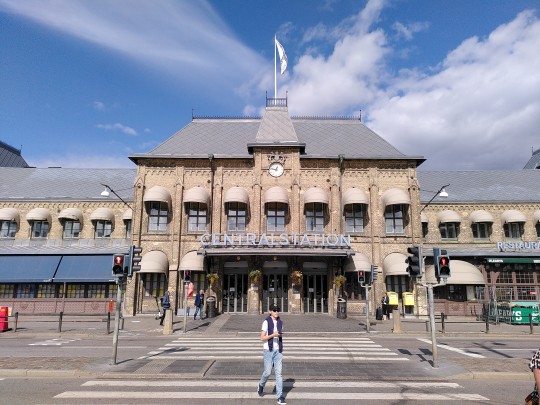
(the front of Gothenburg central station in broad daylight)
From the central station one can easily get anywhere in the city with the many trams or a bus which stop just a hundred meters from the station entrance.
In conclusion
This whole trip is now about two weeks in the past and I had some time to think about it. In general I still think this is a good way to get to Sweden, especially if you are on a budget. Next time I want to try out a proper cabin with a berth on the night train, because I am just too tall to sleep in any way comfortably in a seat.
4 notes
·
View notes